‘Not the kind of life a human should live’
How Namibia’s sanitation crisis is endangering its people and its future (Part One)
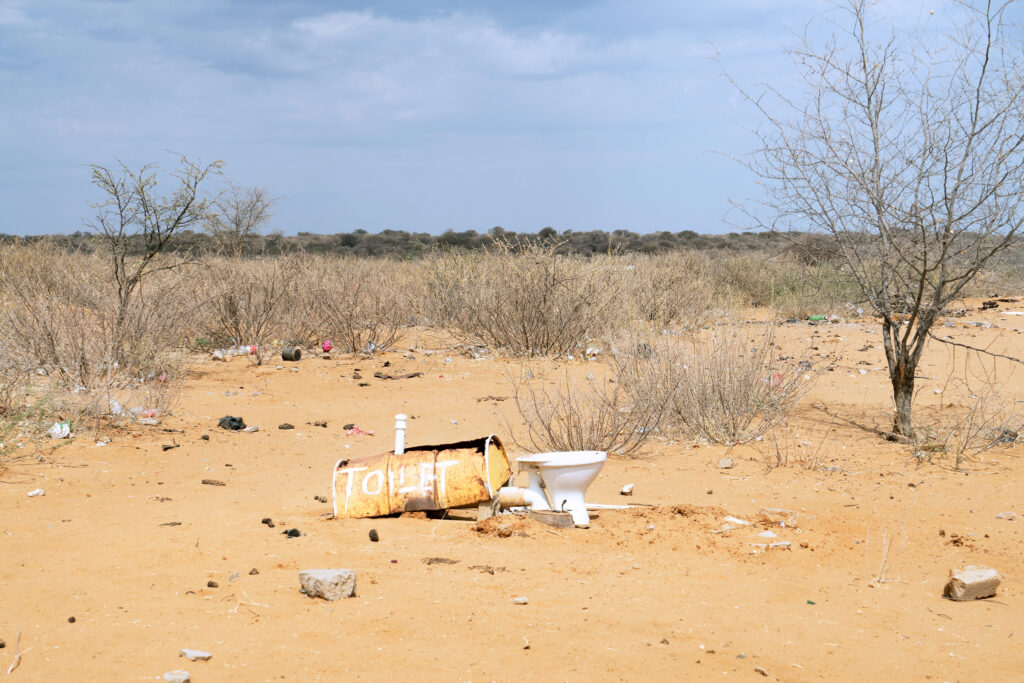
Every day, Natalia Shaanika, 15, escorts her five younger siblings across a busy road to a landfill site to relieve themselves. As they squat – partially hidden by scraps of corrugated iron and used toilet paper – their older sister keeps watch.
When a car comes their way, Shaanika hurries them back half naked toward their shack. Flies swarm over a bucket of water where they each wash their hands.
“We are a family of eight in a shack in a community that has no water points or toilets,” says Shaanika, who resides in Swakopmund’s Democratic Resettlement Community (DRC), one of Namibia’s largest informal settlements, where some 20,000 people live without running water or sewerage.
“Together with our parents, we relieve ourselves in the dump behind our home. When I’m on my period, it’s the same place I go to the toilet and where I throw the used pads,” she adds.
These conditions mean Shaanika and her siblings suffer from frequent infections and bouts of diarrhea, along with the thousands of other men, women and children who use the same and other similar strips of wasteland as toilets in the DRC.
Their struggle is not unique. From the outskirts of cities to the most rural parts of the country, over 1 million Namibians lack adequate access to toilets, and they are often faced with only one option: open defecation.
According to the World Health Organization and UNICEF’s Joint Monitoring Programme (JMP) 2020 data, Namibia ranks sixth for highest rates of open defecation in the world at 47%. Less than half of the country’s 2.5 million citizens use facilities that safely separate waste from human contact, while some 5% use inadequate facilities such as open pits, buckets and hanging latrines.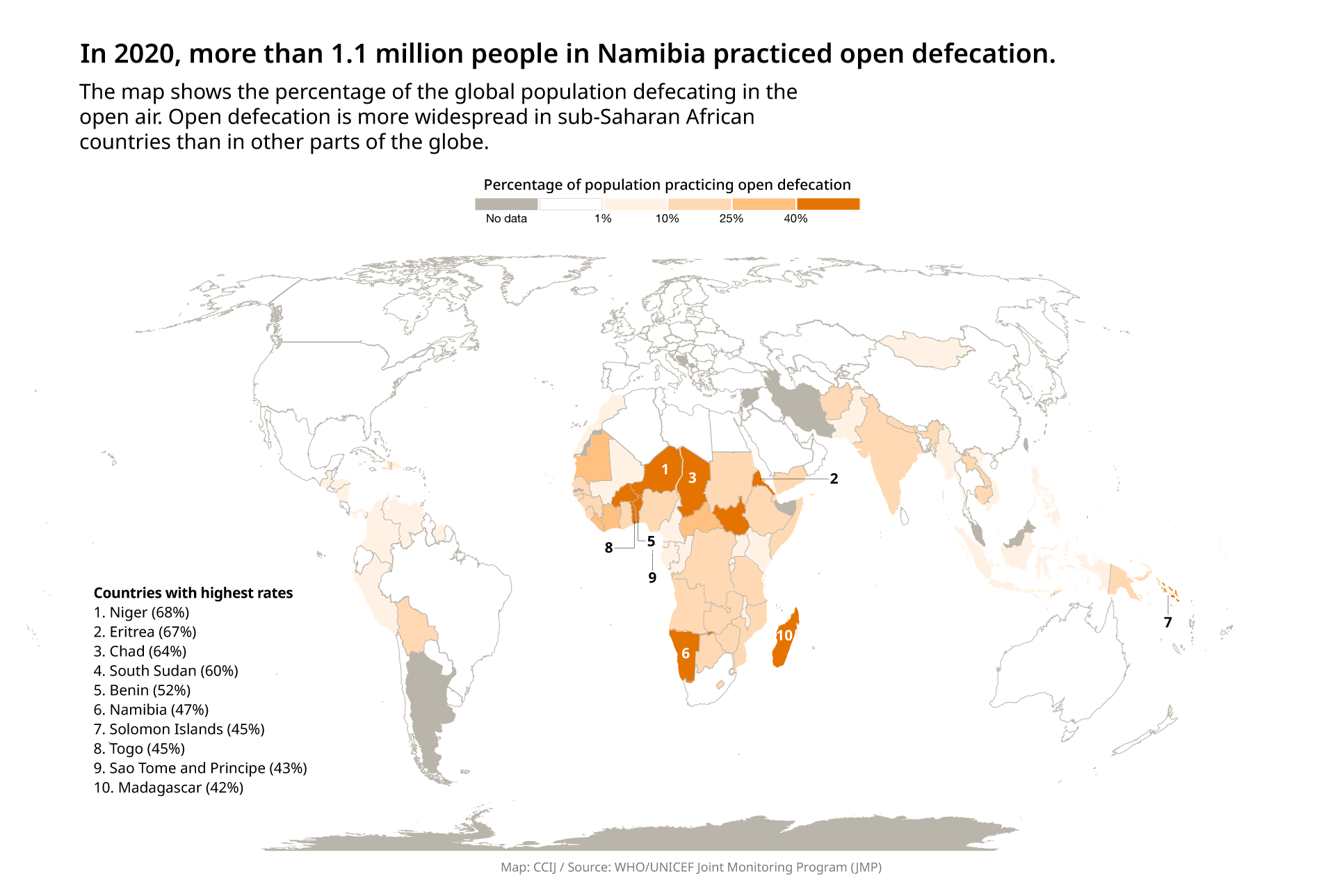 The nation’s severely low levels of sanitation stand in stark contrast to the rest of southern Africa, a region where Namibia ranks the worst for sanitation coverage. Its rates of open defecation are more than double Angola’s to the north and almost five times higher than that of either neighboring Botswana or Zambia.
The nation’s severely low levels of sanitation stand in stark contrast to the rest of southern Africa, a region where Namibia ranks the worst for sanitation coverage. Its rates of open defecation are more than double Angola’s to the north and almost five times higher than that of either neighboring Botswana or Zambia.
The consequences extend far beyond foul odor. The sheer amount of human feces deposited in and around Namibian homes makes avoiding contact and even ingestion almost impossible. Excrement litters the ground in spaces between shacks where children play with dirty hands, and flies travel freely from waste to fluids and food. As feces seep into the environment, crops are contaminated alongside vital water sources used for drinking, cooking and fishing.
These conditions put Namibians, especially children, at risk of deadly fecal-oral diseases and infections that cause diarrhea, the second biggest killer of under fives in the country, while sanitation-related deficiencies such as malnutrition and stunted growth are also prevalent.
“If we don’t change our trajectory, things are definitely going to get worse, especially in the informal settlements and in the rural areas,” said Matheus Shuuya, water, sanitation, and hygiene (WASH) specialist at UNICEF Namibia. “We will experience more children getting sick… I’m sure we will also experience frequent outbreaks of other diseases.”
Education, dignity and safety are in jeopardy, too. Girls’ inability to manage their menstrual health on school premises that lack adequate sanitation leads to increased absenteeism, while Namibians risk rape, robberies and even wildlife attacks as they are forced to seek the privacy of the bush.
Reinard Enrich, 18, was attacked at night while defecating on a landfill in Havana, an informal settlement outside of Windhoek, the nation’s capital. “The absence of toilets has made our situation unsafe,” he said. “I was minding my own business, playing music on my phone. Two men approached me – one grabbed me by my throat, and another grabbed my phone. I couldn’t do anything, so I do not go out when it’s dark anymore.”
However, Namibia has ratified the core international human rights treaties which protect the right to sanitation, while its own constitution calls for “consistent planning to raise and maintain an acceptable level of nutrition and standard of living of the Namibian people and to improve public health.”
Namibia’s 2008 Water and Sanitation Supply Policy outlines that “essential water supply and sanitation services should become available to all Namibians, and should be acceptable and accessible at a cost which is affordable to the country as a whole.” The South West Africa People’s Organization (SWAPO) Party, which has governed the country since independence in 1990, has also committed Namibia to the United Nations’ Sustainable Development Goal Six (SDG6) of ensuring all of its citizens have access to clean water and sanitation by 2030.
But according to JMP data, analyzed by the Center for Collaborative Investigative Journalism (CCIJ), stagnant sanitation levels over the past decade mean Namibia is not on course to hit these targets – not even close. While over 1 million Namibians wait for this basic human right to be granted, the government appears to be taking too few steps to address a crisis that may yet worsen due to climate change and rapid urbanization.
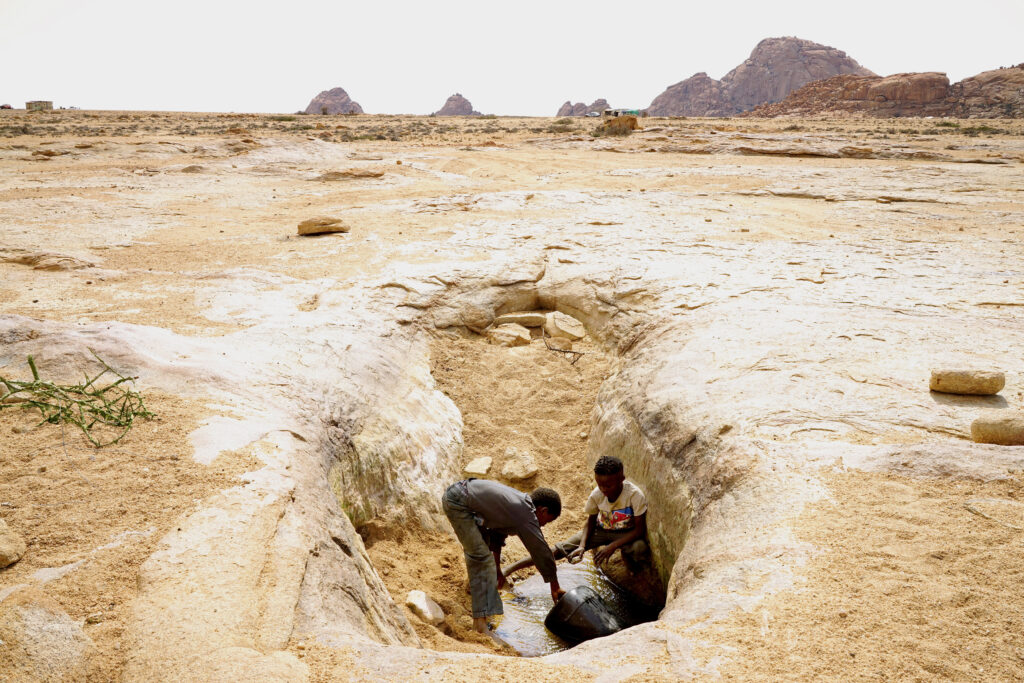
Despite pouring billions of Namibian dollars into sanitation in recent years, the country’s 5th National Development Plan stated that the sanitation sector has suffered from “poor coordination, lack of accountability, and spreading efforts and resources too thinly.” Though the current administration has vowed to improve sanitation access and to invest in educating Namibians on the value of good hygiene, it’s still too early to assess how successful this initiative will be.
Dr. Kalumbi Shangula, Namibia’s Minister for Health and Social Services, recognized the struggles facing Namibians. He told CCIJ that low sanitation was overburdening health services and keeping Namibians out of work, but he remained optimistic that conditions would improve. “[G]radually [sanitation] will catch up… As long as there is good will and people are talking about strategies, there is hope,” he said.
But many Namibians need more than hope.
Hilma Hamalwa, 35, lives a 30-minute walk from Shaanika in the DRC. When she realized that her neighbors were suffering from the same infections and illnesses after using the bush to defecate, she dug a hole in the ground for them — and added four slabs of corrugated iron for a little privacy.
“This is not the kind of life a human being should live,” she says.
The scope of the sanitation problem
Namibia’s informal settlements are among the hardest hit by poor sanitation. According to World Habitat, 40% of Namibians live in informal settlements. And, according to the Namibian Chamber of Environment (NCE), more than half of them lack access to any toilets at all. The NCE also estimates that at least 45 tons of human feces are deposited through open defecation each day in Windhoek’s informal settlements alone.
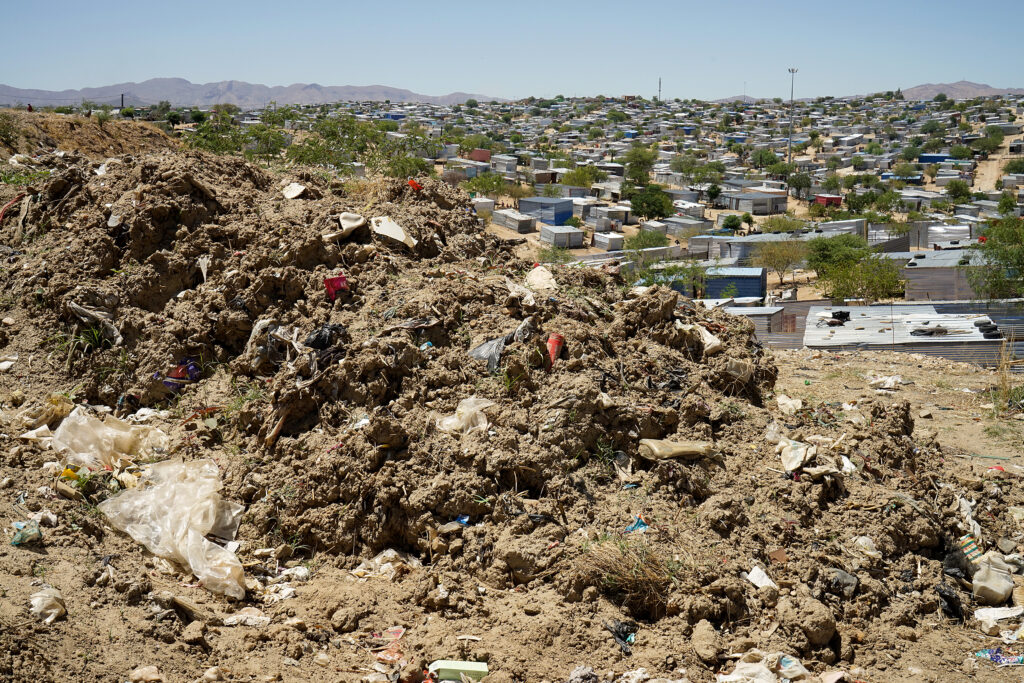
Havana is one of the largest informal settlements, with more than 50,000 shacks that squeeze up against one another. Men, women and children find pockets of dirt to relieve themselves on their way back from church, school or the market. Tissues, sanitary pads and excrement litter the ground.
Several government toilets in Havana are in disrepair, with doors hanging off their hinges and latrines clogged to the brim. For those who have access to these toilets, many choose open defecation as the lesser of two evils.
Johannes Nghidinwa, 53, sits on the deck in front of his shack with his wife, who cradles their five-month-old baby. Their home rests in the shadows of a landfill site that has become one of many open-air communal toilets in Havana. “We are a community of thousands of people, but the toilets here are very few; you can count them on your hands,” he says. “Not a week passes by without any of us getting sick with diarrhea, fever and flu.”
For many others, especially women, the risks of using the bush at night are far too high, and they must defecate inside their own homes instead. Janet Gaes, 34, lives with her four children in Windhoek’s Otjomuise 8ste Laan informal settlement, and her shack sits on a hill overlooking a dry riverbed overflowing with toilet paper. During the day she takes her children to the riverbed, but at night they share a bucket at home.
“We do not go to the riverbed when it’s dark,” she said, washing her one-year-old on the path outside. “People get assaulted there, so at night we use the bucket to relieve ourselves. Then we throw the feces out in the morning and wash [the bucket] again to use for the following night.”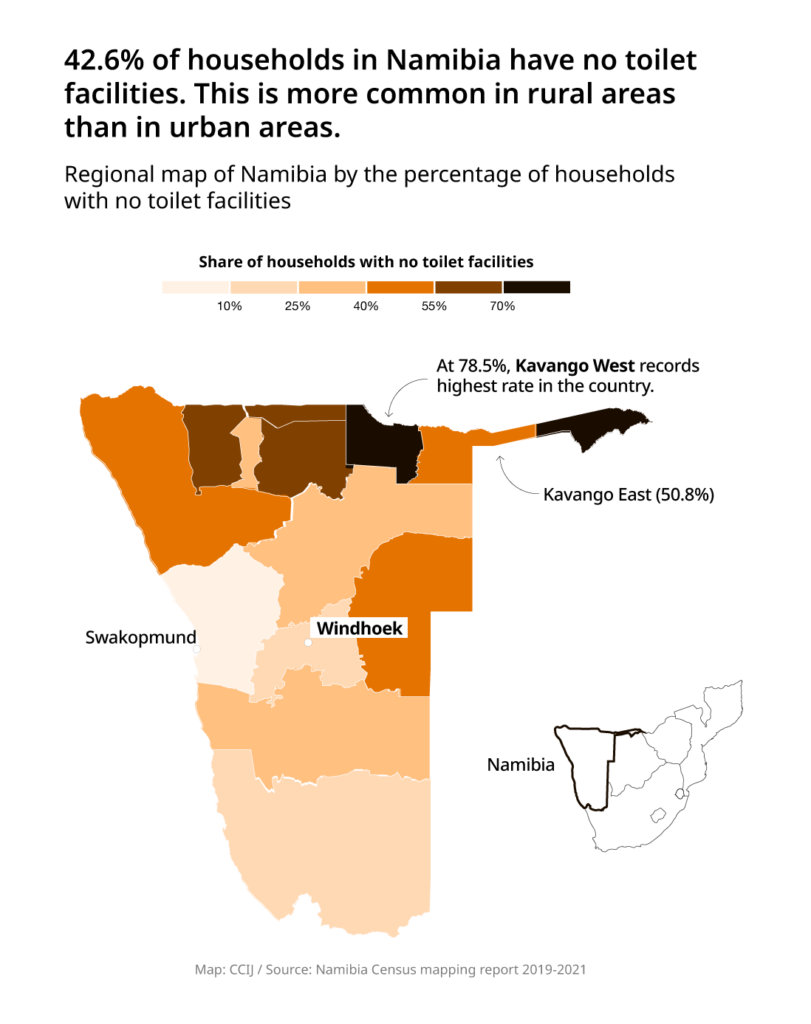 Surpassing 70%, open defecation levels are even higher in the rural areas. According to 2020 data, almost half of Namibians are sprawled throughout sparsely populated villages that dot the horizon. Residents with water struggle to keep that water clean, and those without water often turn to river and groundwater supplies contaminated with their own excrement. Even clinics and schools lack adequate sanitation.
Surpassing 70%, open defecation levels are even higher in the rural areas. According to 2020 data, almost half of Namibians are sprawled throughout sparsely populated villages that dot the horizon. Residents with water struggle to keep that water clean, and those without water often turn to river and groundwater supplies contaminated with their own excrement. Even clinics and schools lack adequate sanitation.
Mukennah Scholastika is the headmistress of a public primary school in rural Kavango East in northern Namibia, where students gather under the heat of classrooms built from corrugated iron. “We have 330 students. Until last month, we had no toilets, and they had to use the bush,” she explained.
“Students come late for class, and they are exposed to dangers in the bush like insects and snakes. Some go home and don’t come back again. Sometimes they even defecate in their clothes. Girls will miss school, especially when they are on their period,” Scholastika added.
She asked the parents to contribute toward the construction of two toilets for the students and one for the staff, each of which were built by the community and are maintained by the teachers. Long queues form before class starts in the morning. “We have one for the boys and one for the girls,” Scholastika noted.
To avoid cross-contamination or contact with excrement is extremely difficult, but keeping clean is a challenge even health professionals face in rural areas. Nurse Sem Tetera, 23, helped to deliver a baby by the side of a road in Kavango West, Namibia’s poorest region with the poorest sanitation coverage. The new mother was rushed to his clinic, a small building with no toilets that only has water when the village chief can afford it.
“It’s a struggle working here,” said Tetera. “Most of the time we have no water, and it is a huge problem for us to work without it.”
In March 2023, Namibian Prime Minister Saara Kuugongelwa-Amadhila said the government had “identified the need to improve universal access to sanitation and hygiene in informal urban settlements and rural communities.”
Indeed, proper sanitation keeps water and food free from contamination, children in school and people healthy and safe from danger. But attempts to provide adequate sanitation have yet to yield significant results in Namibia.
By Frederick Clayton and Sonja Smith
Photography by Margaret Courtney-Clarke
This report was produced by the Center for Collaborative Investigative Journalism (CCIJ), a nonprofit organization that brings together investigative reporters, visual storytellers and data scientists to investigate key global issues affecting underserved communities. This report was supported by the Pulitzer Center.
Ghana Business News is publishing this story in collaboration with CCIJ.
